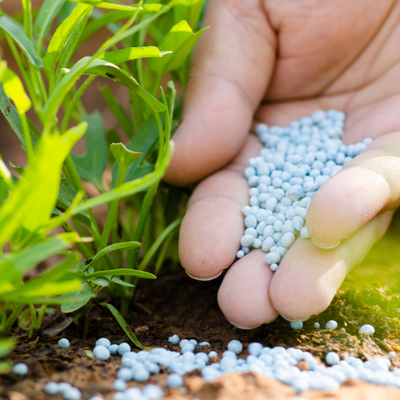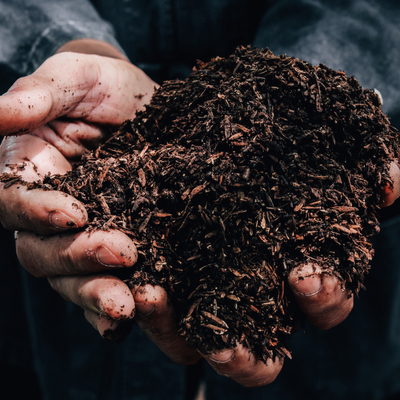Everyone knows that fertilizer is good for your lawn, but what exactly is it? How does it make our lawns look like plush green carpet? That’s the question we’ll explore in today’s blog.
What Goes Into Fertilizer
Fertilizers come in many forms – liquid, granular, etc. – and each fertilizer will have a different breakdown of nutrients, depending on what you need for your lawn. However, they all contain the same three macronutrients: nitrogen, phosphorous, and potassium. You may have noticed that fertilizer has a series of three numbers on it, like 16-12-12 or 3-3-3. This informs you of the proportion of nitrogen,  phosphorous, and potassium – in that order. Your lawn needs all three minerals, but not always in the same portion. At Agxact Lawn and Pest, our lawn care service technicians will help you choose the best solution for your lawn. As we’ll discuss in a moment, having too much of certain minerals in your lawn can actually damage it!
phosphorous, and potassium – in that order. Your lawn needs all three minerals, but not always in the same portion. At Agxact Lawn and Pest, our lawn care service technicians will help you choose the best solution for your lawn. As we’ll discuss in a moment, having too much of certain minerals in your lawn can actually damage it!
Macronutrients
All fertilizers contain both macro and micronutrients. Macros are needed in larger portions than micro, hence the name.
Nitrogen
Even if you know next to nothing about fertilizer, you’ve probably heard that nitrogen is the main component. It’s popular with homeowners in spring because it can speed up your lawn’s greening. Unfortunately, many forget to reapply nitrogen fertilizer in the fall – which helps your grass survive the winter. Nitrogen helps with leaf development, chlorophyll formation, and photosynthesis. And it comes in two different forms for usage at different times of the year: slow-release and quick-release.
Fast-release fertilizer
Usually water-soluble, this kind of fertilizer is sold in bottles that attach to your garden hose for easy dilution and dispersal at the same time. Remember to be careful when using this fertilizer because it may cause a large flush of uneven growth. The drawback with this type of fertilizer is that it tends to dissolve quickly – especially if there’s a lot of rain shortly after applying it, which means you might have to reapply.
In late summer and early fall, we’d recommend a slow-release fertilizer so that it lasts through winter. These fertilizers tend to be granular so that they will dissolve more slowly. More on this later.
Phosphorous
Phosphorous is needed for early root growth, seed formation and helps grass reach maturity faster. Mature grass is more likely to tolerate fluctuations in temperature and has a better defense against broadleaf weeds, surface insects, and lawn diseases.
Potassium
Potassium toughens up grass – something we need in summer and early fall. All the heat and sunlight can cause the grass to become brittle, making it difficult to bounce back after drought conditions. Keeping a balanced potassium level in your lawn will help your grass regulate its processes and boost its tolerance to stress like drought. Potassium also aids with root growth and stem development.
Micronutrients
If you’ve ever read the label on your multivitamin, you might have noticed that some minerals give you 100% of the daily value while others have barely any percentage. That’s because your body needs certain minerals in a smaller dose. The grass is just the same. It needs micronutrients, but they aren’t as important as the macros. Typically, micronutrients are boron, chlorine, copper, iron, manganese, nickel, and zinc. They help your grass with processes like chlorophyll production, photosynthesis, DNA synthesis, disease resistance, and other vital functions.
Forms Of Fertilizer
Fertilizers come in several different forms, and each has pros and cons, depending on what you need to accomplish for your lawn.
Organic
Often this type of fertilizer is repurposed poo from agricultural areas. Organic fertilizers are easier for the lawn to digest and will break down slowly over time. If you’re uneasy with using traditional chemical  fertilizers, this might be a good option for you.
fertilizers, this might be a good option for you.
Synthetic
These types of fertilizer are water-soluble and fast-acting. If your lawn is damaged, or you haven’t yet fertilized this season, this might be the way to go.
Granular
Granules will break down slowly and melt into the lawn instead of dissolving quickly like the liquid or synthetic options. This is a good option for the final lawn care treatment in the fall. By distributing slow-release fertilizer now, your lawn will have a supply of nutrients to last all winter.
Liquid
Liquid fertilizer will green up your lawn quickly and is usually preferred in spring to bring about the green faster.
Where We Service
We currently service these locations and more!
To learn more or to schedule an appointment, give us a call today at 937-949-8199, or you can leave us a message online. And don’t forget to check out our blog page and Facebook for more helpful articles, photos of work, and the latest deals.
